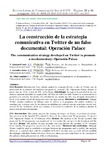| dc.contributor.author | Quintas-Froufe, Natalia | |
| dc.contributor.author | González-Neira, Ana | |
| dc.contributor.author | Díaz-González, María-Jesús | |
| dc.date.accessioned | 2016-02-02T08:34:45Z | |
| dc.date.available | 2016-02-02T08:34:45Z | |
| dc.date.issued | 2015-01-01 | |
| dc.identifier.citation | N Quintas-Froufe, A González-Neira, MJ Díaz-González (2015): “La construcción de la estrategia comunicativa en Twitter de un falso documental: Operación Palace”. Revista Latina de Comunicación Social, 70, pp. 28 a 48. | es_ES |
| dc.identifier.issn | 1138-5820 | |
| dc.identifier.uri | http://hdl.handle.net/2183/15955 | |
| dc.description.abstract | [Resumen]: Introducción: Este artículo analiza la estrategia llevada a cabo en Twitter para la promoción de la emisión del polémico programa El especial 23F: Operación Palace durante el prime time del 23 de febrero de 2014 en La Sexta. Metodología: Se registró la actividad de las seis cuentas emisoras haciendo un seguimiento del flujo de todos los tuits durante la semana previa y posterior a la emisión. Resultados. La actividad de sus cuentas ha sido muy desigual, destacando a Évole y la cuenta oficial del programa como las más activas. Discusión y conclusiones: Aunque Twitter permite establecer un diálogo entre el público y el programa, del análisis realizado se concluye que la mayor parte de las cuentas no entablan ese contacto con sus seguidores en esta red, excepto Évole. Asimismo, desde esas cuentas se favoreció la confusión de la audiencia durante la promoción del falso documental | es_ES |
| dc.description.abstract | [Abstract]: Introduction. This article analyses the strategy developed on Twitter to promote the prime-time premiere in the Spanish TV network La Sexta of the controversial TV programme El especial 23F: Operación Palace on 23 February 2014. Method. The activity of six Twitter accounts that promoted the TV programme was monitored for two weeks: the one prior to the broadcast and the one after. Results. The activity of these accounts was very uneven; the accounts of TV Presenter Évole and the TV programme stood out as the most active. Discussion and conclusions. Although Twitter could be used to establish a dialogue between the programme and its public, the analysis allows us to conclude that, with the exception of Évole’s account, most accounts did not establish this dialogue with their Twitter followers. Moreover, these accounts contributed to the confusion of the audience during the promotion of the mockumentary. | es_ES |
| dc.language.iso | spa | es_ES |
| dc.publisher | Revista Latina de Comunicación Social | es_ES |
| dc.relation | http://hdl.handle.net/2183/16150 | |
| dc.relation.uri | http://dx.doi.org/10.4185/RLCS-2015-1033 | es_ES |
| dc.rights | LICENCIA CREATIVE COMMONS: Autoría-no derivados, no-comercial | es_ES |
| dc.subject | Audiencia social | es_ES |
| dc.subject | Twitter | es_ES |
| dc.subject | Falso documental | es_ES |
| dc.subject | Redes sociales | es_ES |
| dc.subject | Televisión | es_ES |
| dc.subject | Audiencia | es_ES |
| dc.subject | Social audience | es_ES |
| dc.subject | Twitter | es_ES |
| dc.subject | Mockumentary | es_ES |
| dc.subject | Social networks | es_ES |
| dc.subject | Television | es_ES |
| dc.subject | Audience | es_ES |
| dc.title | La construcción de la estrategia comunicativa en Twitter de un falso documental: "Operación Palace" | es_ES |
| dc.title.alternative | The communication strategy developed on Twitter to promote a mockumentary: "Operación Palace" | es_ES |
| dc.type | info:eu-repo/semantics/article | es_ES |
| dc.rights.access | info:eu-repo/semantics/openAccess | |






